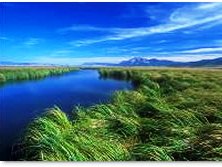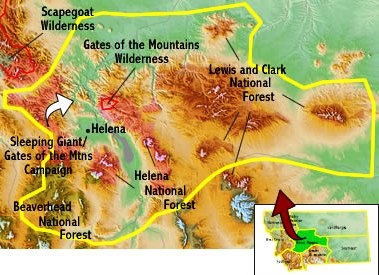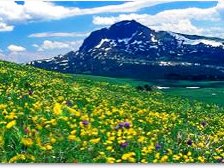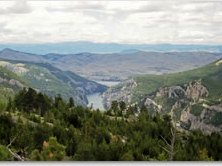» posted on Tuesday, August 7th, 2012 by Linda Lou Burton
Going Wild
 Linda Burton posting from Helena, Montana – Montana is big. 94,109,542 acres big, to be precise. It is a state of riches, overflowing with nature’s generosity. And since the passage of the Wilderness Protection Act of 1964, signed into law by Lyndon Johnson, 3,443,038 acres of that land (about 3.7%) have become designated wilderness areas. Enthralled by the landscape around me, I’m getting information from the Montana Wilderness Association (MWA). Headquartered in Helena, the organization was founded in 1958 by Ken and Florence Baldwin; it was the nation’s first state organization concerned with wilderness preservation and the management of public lands. This nonprofit’s mission is
Linda Burton posting from Helena, Montana – Montana is big. 94,109,542 acres big, to be precise. It is a state of riches, overflowing with nature’s generosity. And since the passage of the Wilderness Protection Act of 1964, signed into law by Lyndon Johnson, 3,443,038 acres of that land (about 3.7%) have become designated wilderness areas. Enthralled by the landscape around me, I’m getting information from the Montana Wilderness Association (MWA). Headquartered in Helena, the organization was founded in 1958 by Ken and Florence Baldwin; it was the nation’s first state organization concerned with wilderness preservation and the management of public lands. This nonprofit’s mission is “to protect Montana’s wilderness heritage, quiet beauty and outdoor traditions, now and for future generations.” The ensuing years have seen coalitions and controversies, lawsuits and victories. In 1964 some of Montana’s best-known wilderness areas were designated – Bob Marshall, Cabinet Mountains, Gates of the Mountains, Selway-Bitterroot, and Anaconda-Pintler. By 1978 the Lincoln-Scapegoat, Great Bear, Rattlesnake, Absaroka-Beartooth, Mission Mountains, Welcome Creek, UL Bend, Medicine Lake, and Red Rock Lakes areas were added; more campaigns continue.
“to protect Montana’s wilderness heritage, quiet beauty and outdoor traditions, now and for future generations.” The ensuing years have seen coalitions and controversies, lawsuits and victories. In 1964 some of Montana’s best-known wilderness areas were designated – Bob Marshall, Cabinet Mountains, Gates of the Mountains, Selway-Bitterroot, and Anaconda-Pintler. By 1978 the Lincoln-Scapegoat, Great Bear, Rattlesnake, Absaroka-Beartooth, Mission Mountains, Welcome Creek, UL Bend, Medicine Lake, and Red Rock Lakes areas were added; more campaigns continue.
 Dividing the state into eight regions — Northwest, West Central, Southwest, Rocky Mountain Front, Central Ranges, Greater Yellowstone, Northeast, and Southeast – for the purpose of this post I focused only on the region which includes Helena, known as the Central Ranges. Filled with rugged mountain peaks, historic landscapes, glacial cirques with gem-like lakes, and steep-sided forested valleys, here in the Central Ranges the Continental Divide lies close to Helena, Butte, Deer Lodge, Great Falls, Lincoln, and Wolf Creek; here you’ll find the Big Belt and Elkhorn Mountains, the southern portions of the Rocky Mountain Front, and the Bob Marshall Wilderness (known as “The Bob).
Dividing the state into eight regions — Northwest, West Central, Southwest, Rocky Mountain Front, Central Ranges, Greater Yellowstone, Northeast, and Southeast – for the purpose of this post I focused only on the region which includes Helena, known as the Central Ranges. Filled with rugged mountain peaks, historic landscapes, glacial cirques with gem-like lakes, and steep-sided forested valleys, here in the Central Ranges the Continental Divide lies close to Helena, Butte, Deer Lodge, Great Falls, Lincoln, and Wolf Creek; here you’ll find the Big Belt and Elkhorn Mountains, the southern portions of the Rocky Mountain Front, and the Bob Marshall Wilderness (known as “The Bob).
 This region also includes the Little Belt, Highwood, Big Snowy, Little Snowy, Castle and Crazy Mountains, often described as island ranges floating in the sea of the Northern Plains. These” islands on the prairie” are home to diverse communities of plants and animals and include over 20 roadless areas and two Wilderness Study Areas. The Montana Wilderness Association supports appropriate use of motorized vehicles on public land, but believes there need to be places where motorized vehicles are not allowed. No island ranges have yet been designated as Wilderness Areas.
This region also includes the Little Belt, Highwood, Big Snowy, Little Snowy, Castle and Crazy Mountains, often described as island ranges floating in the sea of the Northern Plains. These” islands on the prairie” are home to diverse communities of plants and animals and include over 20 roadless areas and two Wilderness Study Areas. The Montana Wilderness Association supports appropriate use of motorized vehicles on public land, but believes there need to be places where motorized vehicles are not allowed. No island ranges have yet been designated as Wilderness Areas.
 The historic Gates of the Mountains Wilderness and the Sheep Creek and Sleeping Giant areas lie a few miles north of the capital city of Helena. The “Gates of the Mountains” were named by the Corps of Discovery as they followed the Missouri River on their journey westward in 1805. They also camped and hunted below the Sleeping Giant; a portion of this area is included in the Lewis and Clark National Historic Trail. To the south, on Helena’s doorstep, are the Elkhorn Mountains, which contain one of the largest unprotected tracts of wildland in Montana. The Elkhorns support an abundance of wildlife, including grizzly and black bear, bighorn sheep, mountain goat, moose, elk, mule and whitetail deer, lynx, and wolverine.
The historic Gates of the Mountains Wilderness and the Sheep Creek and Sleeping Giant areas lie a few miles north of the capital city of Helena. The “Gates of the Mountains” were named by the Corps of Discovery as they followed the Missouri River on their journey westward in 1805. They also camped and hunted below the Sleeping Giant; a portion of this area is included in the Lewis and Clark National Historic Trail. To the south, on Helena’s doorstep, are the Elkhorn Mountains, which contain one of the largest unprotected tracts of wildland in Montana. The Elkhorns support an abundance of wildlife, including grizzly and black bear, bighorn sheep, mountain goat, moose, elk, mule and whitetail deer, lynx, and wolverine.
 The Montana Wilderness Association advocates permanent protection for these roadless landscapes; you can join a group for a wilderness walk, or get more information about the Sleeping Giant/Gates of the Mountains Wilderness Campaign and the Beaverhead-Deerlodge Partnership at Campaigns, Montana Wilderness Association, 30 S Ewing, Helena, MT 59601, 406.443.7350, http://www.wildmontana.org/index.php
The Montana Wilderness Association advocates permanent protection for these roadless landscapes; you can join a group for a wilderness walk, or get more information about the Sleeping Giant/Gates of the Mountains Wilderness Campaign and the Beaverhead-Deerlodge Partnership at Campaigns, Montana Wilderness Association, 30 S Ewing, Helena, MT 59601, 406.443.7350, http://www.wildmontana.org/index.php
